Timelines
The Subreddits With the Most Comments, Every Single Day from 2018-2021
At any specific date in time, trending Reddit subs can provide a snapshot to what users are thinking, searching and talking about. Sports, politics, gaming, current events and more can significantly boost comment numbers in specific Subreddits. This animated bar graph visualization from u/Balloon_Project, which was shared in the Data is Beautiful Subreddit, shows the most commented subreddits from 2018 to Jan 27th 2021. Check it out here:
Click the video to play and pause
Most commented subreddits, 2018-21 [OC] from r/dataisbeautiful
Using information from SubredditStats.com, Balloon_Project was able to write a custom script in a program called Processing to input all the data. In the 2 and a half minute video, you can watch subreddits move and up and down the ladder with an accompanying “Todays’ News” headline for that specific day. It is fun to watch the different spikes that show up around different events. For example, the subreddit r/marvelstudios shows up high on the graph when Endgame gets released.
Sports subreddits like r/nba and r/nfl peak during key events for their respective leagues, and r/politics jumps to the top for major events surrounding the election, impeachment, protests, and riots. Meme pages and general subs like r/pics, r/teeenagers, and r/funny tend to bounce around in the top ten spots randomly as they are consistently popular subreddits. The general info sub r/askreddit where users can ask any question that comes to mind stayed in the top position for years getting 80 to 120k comments per day.
Here are some notable events and how Reddit reacted:
- At the start of the COVID-19 pandemic in March, you can watch r/coronavirus surge to around 60 thousand comments per day.
- Around the election in November of 2020, the r/politics sub surges past 200k comments per day, the highest number seen in the video to that point.
- Rounding out the last days of the graph you can watch the Wall Street Bets sub (r/wallstreetbets) soar to incredible new levels on the graph, getting close to 400 thousand comments per day during the whole GameStop stock debacle.
What a neat way to visualize this data!
Business Visualizations
Billionaires Who Built Up from Small Businesses
The world of entrepreneurship loves the tale of a small business startup that grew into a billion-dollar business. The team at Ooma illustrated the biggest names in this world of billionaires with a timeline showing how long it took them to reach their status from a small business start-up to a billion-dollar milestone.
Click below to zoom.
The graphic features 28 billionaires who built up from a small business. All names were pulled from the Forbes 400 list. While the graphic is stuffed full of details, the most fascinating is the measure of how many years they needed to become billionaires.
The first person to achieve the “self-made” billionaire status was John D. Rockefeller in 1916. The oil tycoon rode the wave of the industrial era to billionaire status. Today, there are almost 3,000 billionaires worldwide. The U.S. is home to the highest number, at 813 billionaires. We can see an industry trend in this graphic, which is that tech dominates. This is no surprise. As Rockefeller benefited from the need for oil, how we worked and what we produced changed completely, and tech has changed every aspect of our lives, so it’s no surprise that these entrepreneurs have reaped the rewards.
Notable examples are Bill Gates, founder of Microsoft, who led the way in introducing the personal computer to the general public. Warren Buffett took a different approach. He grew wealth by investing wisely in assets. Elon Musk started his first business with Zip2 in the early days of the Internet.
The Billionaire Journeys
The chart shows us that it took different people vastly different amounts of time to reach their status. Bezos and Zuckerberg were the fastest, becoming billionaires in just four years. Others like Donald Bern and John Menard Jr. had a slow build that took 43 years. Many people land somewhere in between these extremes, emphasizing that successful entrepreneurship takes dedication and persistence. We also see on that chart that there is only one woman, Diane Hendricks. This suggests that entrepreneurship and business are still rife with bias.
The Journeys of the Top 10 Billionaires
This is how long the wealthiest billionaires took to hit their status:
- Jeff Bezos: 4 years
- Mark Zuckerberg: 4 years
- Jan Koum: 5 years
- Larry Page: 6 years
- Sergey Brin: 6 years
- Henry Samueli: 9 years
- Bill Gates: 12 years
- Michael Dell: 12 years
- Steve Cohen: 12 years
- David Tepper: 13 years
Many people on this list transformed their industries, showing that successful entrepreneurs are creative and innovative. They show us that entrepreneurs should look for emerging trends in their industry, leverage new technology, and make strong investments. While a lot depends on love, it’s clear that persistence is key. The list gives us an idea of what kind of industries people can generate billion-dollar businesses in and how long it might take to get there. This chart is a great introduction to these business pioneers, and many of these billionaires have published books and given out advice on how they made their businesses a success.
Misc Visuals
Exploring Science Fiction Technology That Became a Reality
Science fiction often features futuristic technology that once seemed unimaginable. Yet, many sci-fi stories have accurately predicted innovations that eventually became real. Throughout history, countless fictional inventions have transitioned from mere ideas to actual advancements. This fascinating work from AI PRM illustrates the time gap between when these imaginative concepts first appeared in fiction and when they were finally brought to life.
Click below to zoom.
Their research examined sci-fi technology that exists today in these categories:
- Space Exploration
- Communication
- Robotics and AI
- Health and Biotechnology
- Weapons and Defense
When the 1927 film Metropolis became a hit, it was difficult to imagine that the video calls in the movie would ever become a reality, but today, this is a commonplace technology we rely on. The team shows us that the first real-world video phone was created by AT&T in 1964. In 2003, Skype made video calls widely accessible.
As for artificial intelligence in our lives, E.M. Forster’s The Machine Stops depicted a world where people had automated phones that could respond to their commands and help them manage their lives. This became a common trope in science fiction, but today, with the rise of devices like Alexa and Google Home, this technology doesn’t seem unusual at all. Believe it or not, when Jules Verne’s Twenty Thousand Leagues Under the Sea was released in 1870, submarines seemed like a feat of imagination to the reading public. But the Nautilus was inspired by a French sub prototype. The first submarine was launched just a few years later by Isaac Peral in 1888. Explore more technology once thought impossible throughout the team’s article.
Timelines
Timeline Charts the Development of Communications Technology
Humans are unique because of our sophisticated ability to communicate with one another. What we’re doing right now is a perfect example. Chartistry is showing you the timeline created by the Ooma team who used data from universities and libraries to create a visual representation of changing communications technology. They communicate it to us through pictures and words expressed through pixels, brought to us all by the connective power of the Internet, allowing you to learn something new in a matter of minutes. That alone is an impressive feat of communication! So, how did such a complex system of communication become commonplace? Well, this timeline shows us. A series of pivotal inventions and developments brought us from the first cave paintings to the 5g phone in your pocket.
Click below to zoom
The timeline starts in 100,000 BC and takes us all the way to present day, highlighting the most important communications technology with an image of each development, a description of why it made an impact, and the date it emerged. Along this long, winding path, we find inventions like the printing press. This creation allowed the written word to spread further and inspired more humans to learn to read. The telegram emerged centuries later inspiring the revolutionary first telephone in 1876.
After the telephone, radio waves opened all new avenues of communication by ushering in the age of radio broadcast and television, allowing humans to keep up with news all over the world. This concept was, of course, perfected by the Internet connecting humans on a global scale. This timeline highlights how deeply humans are driven to connect with each other.
-
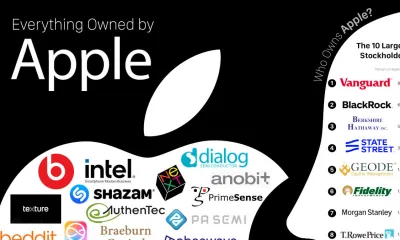
 Business Visualizations8 months ago
Business Visualizations8 months agoEverything Owned by Apple
-
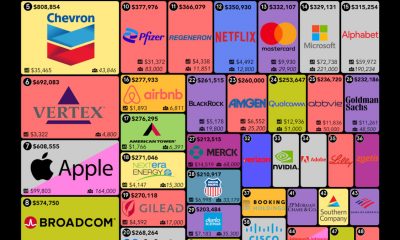
 Business Visualizations6 months ago
Business Visualizations6 months agoAmerica’s Most Valuable Companies Ranked by Profit per Employee
-
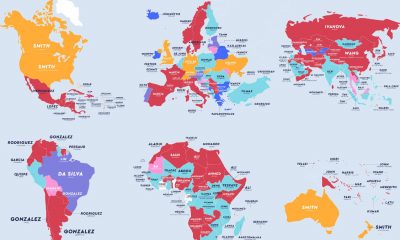
 Maps2 years ago
Maps2 years agoThe Most Popular Surnames in Countries Around the World
-
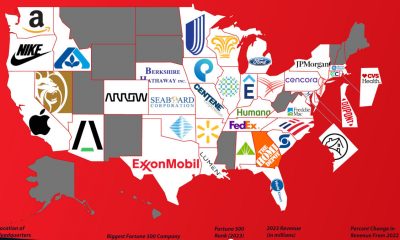
 Business Visualizations2 months ago
Business Visualizations2 months agoThe Biggest Fortune 500 Company in Every State
-

 Misc Visuals2 years ago
Misc Visuals2 years agoHow to Pick a Perfect Watermelon
-
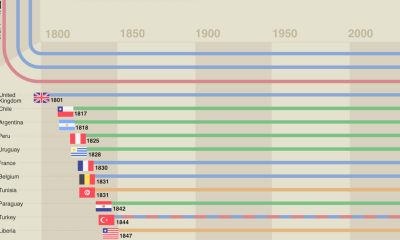
 Timelines1 year ago
Timelines1 year agoA History of the Oldest Flags in the World
-
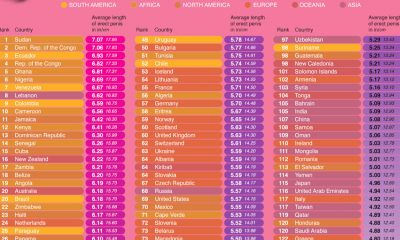
 Maps1 year ago
Maps1 year agoPenis Lengths Around the World
-
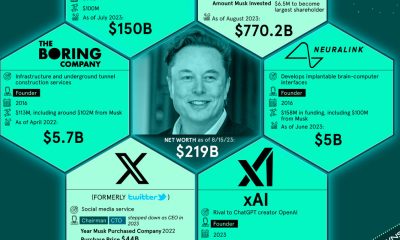
 Business Visualizations2 years ago
Business Visualizations2 years agoHow Many Companies Does Elon Musk Own?



